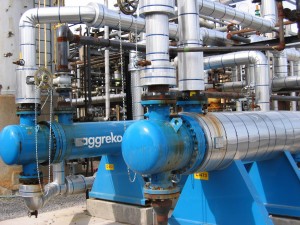Wet gas compressor (WGC) capacity limitations during peak summer gasoline demand can be traced back to rising ambient temperatures, leading to increased wet gas production. Under these circumstances, targeting heat removal at the main fractionator (MF) overhead (OVHD) circuit can effectively resolve the summer time WGC capacity constraint with externally supplied cooling systems.
WGC limits begin showing up as either lube oil temperature problems or elevated discharge compressor temperature constraints due to insufficient interstage cooling in the WGC, which is basically a two-stage centrifugal compressor. The WGC draws suction from the MF OVHD, compresses the OVHD material in the first stage, and is then cooled before entering the interstage drum.
Conceptual evaluation of options for improving heat removal from the MF OVHD system can pinpoint the factors leading to conditions constraining WGC capacity. In summer high ambient temperature conditions, factors such as fouling coincide with reduced heat removal efficiency (e.g., heat exchanger [HE] fouling). Preferably, heat needs to be removed with an engineered solution that avoids capital infusion.
In one operational case, heat removal options were evaluated on the basis of Aggreko-supplied temporary cooling equipment (chillers, pumps, HEs, etc.). The optimal solution selected after the detailed design evaluation lead to specifying assets capable of achieving targeted MF OVHD heat removal. Should a cooling water chiller be specified, the most optimal choice of cooling water media will also need to be selected (e.g., water, ethylene glycol, propylene glycol, etc.). In one case, a single large mechanical chilling unit successfully provided adequate coolant for MF OVHD heat removal, reducing off-gas production and thereby unloading the WGC while also increasing condensation of LPG range material.
One Midwest refiner wanted to avoid having to scale back FCC gasoline output as summer temperatures increased and the volume-driven WGC’s capacity started bumping up against limits. Aggreko studied the FCC unit’s MF OVHD system with a view to utilizing readily available cooling equipment. A temporary cooling solution was engineered based on mechanical refrigeration for OVHD heat removal, decreasing off-gas production and allowing for FCC unit operation at targeted conditions. Assembling the equipment and performing the installation at the refinery was achieved in a one week effort, including delivery of required equipment to the FCC site for hard pipe fabrication.
According to Aggreko’s Advanced Process Services’ engineering manager, Mike Karlin, “Major rotating equipment assets like the WGC, while key to maintaining unit run lengths, are generally lacking in measurement systems to monitor performance, such as for alerting when efficiency deteriorates, which can provide early detection of a potential shutdown.” Karlin also noted that, “In these instances, a practical solution is to target those ‘pain points’ [e.g., WGC capacity limits] based on mechanical refrigeration to chill water for use in refinery grade temporary heat exchangers for added lube oil and interstage cooling.”








Leave a Reply
You must be logged in to post a comment.